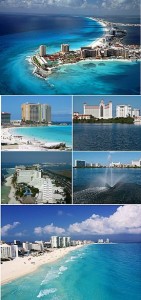[vc_row type=”standard_section” bg_image=”” bg_repeat=”stretch” parallax_bg=”” stellar_class=”default” bg_color=”” section_arrow=”” video_bg=”” enable_video_color_overlay=”” video_overlay_color=”” video_webm=”” video_mp4=”” video_ogv=”” video_image=”” text_color=”dark” custom_text_color=”” text_align=”left” top_padding=”10″ bottom_padding=”” class=”” row_id=””][vc_column animation=”none” bg_color=”” bg_image=”” column_padding=”no-padding” column_custompadding=”0px 0px 0px 0px” column_center=”” text_color=”dark” custom_text_color=”” text_align=”left” width=”1/1″][vc_column_text]
Cancún, Mexico
 Cancún (/kaːnˈkuːn/; Spanish pronunciation: [kaŋˈkun]) is a city in southeastern Mexico, located on the northeast coast of the Yucatán Peninsula in the Mexican state of Quintana Roo. It is an important renowned tourist destination in Mexico, as well as being the seat of the municipality of Benito Juárez. The city is located on the Caribbean Sea, and is one of the easternmost points in Mexico. Cancún is located just north of Mexico’s Caribbean coast resort band known as the Riviera Maya. In older English-language documents, the city’s name is sometimes spelled “Cancoon,” an attempt to convey the sound of the name.
Cancún (/kaːnˈkuːn/; Spanish pronunciation: [kaŋˈkun]) is a city in southeastern Mexico, located on the northeast coast of the Yucatán Peninsula in the Mexican state of Quintana Roo. It is an important renowned tourist destination in Mexico, as well as being the seat of the municipality of Benito Juárez. The city is located on the Caribbean Sea, and is one of the easternmost points in Mexico. Cancún is located just north of Mexico’s Caribbean coast resort band known as the Riviera Maya. In older English-language documents, the city’s name is sometimes spelled “Cancoon,” an attempt to convey the sound of the name.
As documented in the earliest colonial sources, the island of Cancún was originally known to its Maya inhabitants as Nizuc (Yucatec Maya [niʔ suʔuk]) meaning either “promontory” or “point of grass”. In the years after the Conquest, much of the Maya population died off or left as a result of disease, warfare, piracy, and famines, leaving only small settlements on Isla Mujeres and Cozumel Island.[citation needed]
The name Cancún, Cancum or Cankun first appears on 18th-century maps. The meaning of Cancún is unknown, and it is also unknown whether the name is of Maya origin. If it is of Maya origin, possible translations include “Place/Seat/Throne of the Snake” or “Enchanted Snake”. Snake iconography was prevalent at the pre-Columbian site of Nizuc.[/vc_column_text][/vc_column][/vc_row][vc_row type=”standard_section” bg_image=”” bg_repeat=”stretch” parallax_bg=”” stellar_class=”default” bg_color=”” section_arrow=”” video_bg=”” enable_video_color_overlay=”” video_overlay_color=”” video_webm=”” video_mp4=”” video_ogv=”” video_image=”” text_color=”dark” custom_text_color=”” text_align=”left” top_padding=”10″ bottom_padding=”25″ class=”” row_id=””][vc_column animation=”none” bg_color=”” bg_image=”” column_padding=”no-padding” column_custompadding=”0px 0px 0px 0px” column_center=”” text_color=”dark” custom_text_color=”” text_align=”left” width=”1/1″][vc_column_text]
[/vc_column_text][/vc_column][/vc_row][vc_row type=”standard_section” bg_image=”” bg_repeat=”stretch” parallax_bg=”” stellar_class=”default” bg_color=”” section_arrow=”” video_bg=”” enable_video_color_overlay=”” video_overlay_color=”” video_webm=”” video_mp4=”” video_ogv=”” video_image=”” text_color=”dark” custom_text_color=”” text_align=”left” top_padding=”” bottom_padding=”” class=”” row_id=””][vc_column animation=”none” bg_color=”” bg_image=”” column_padding=”no-padding” column_custompadding=”0px 0px 0px 0px” column_center=”” text_color=”dark” custom_text_color=”” text_align=”left” width=”1/1″][vc_column_text]
Travel Tips
Traveling can increase your chances of getting sick. A long flight can increase your risk for deep vein thrombosis. Once you arrive, it takes time to adjust to the water, food, and air in another place. Water in developing countries can contain viruses, bacteria, and parasites that cause stomach upset and diarrhea. Be safe by using only bottled or purified water for drinking, making ice cubes, and brushing your teeth. If you use tap water, boil it or use iodine tablets. Food poisoning can also be a risk. Eat only food that is fully cooked and served hot. Avoid unwashed or unpeeled raw fruits and vegetables.
If you are traveling out of the country, you might also need vaccinations or medicines to prevent specific illnesses. Which ones you need will depend on what part of the world you’re visiting, the time of year, your age, overall health status, and previous immunizations. See your doctor 4 to 6 weeks before your trip. Most vaccines take time to become effective.[/vc_column_text][/vc_column][/vc_row][vc_row type=”standard_section” bg_image=”” bg_repeat=”stretch” parallax_bg=”” stellar_class=”default” bg_color=”” section_arrow=”” video_bg=”” enable_video_color_overlay=”” video_overlay_color=”” video_webm=”” video_mp4=”” video_ogv=”” video_image=”” text_color=”dark” custom_text_color=”” text_align=”left” top_padding=”10″ bottom_padding=”20″ class=”” row_id=””][vc_column animation=”none” bg_color=”” bg_image=”” column_padding=”no-padding” column_custompadding=”0px 0px 0px 0px” column_center=”” text_color=”dark” custom_text_color=”” text_align=”left” width=”1/1″][vc_column_text]
[/vc_column_text][/vc_column][/vc_row]












